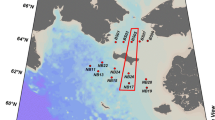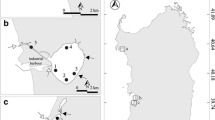Abstract
We investigated the abundance of different picophytoplankton groups and the phytoplankton pigment ratio in relation to environmental factors such as nutrients and suspended solids along a salinity gradient in the Changjiang River Estuary. The average numbers of Synechococcus spp. (Syn) and picoeukaryotes (Euk) were (2.7 ± 5.1) ×103 and (1.1±1.4) ×103 cells mL−1, respectively. Prochlorococcus spp. (Pro) was only found in the high-salinity brackish water with the concentration of 3.0×103 cells mL−1. Syn and Euk numbers both tended to increase offshore and Syn showed a larger variation in cell abundance than Euk. The contribution of picophytoplankton to total phytoplankton biomass increased with increasing salinity and decreasing nutrient concentrations from the estuary to the open ocean. The response of different picophytoplankton groups to environmental variables was different. Water temperature was more important in its control over Euk than over Syn, while nutrients were more important in their influence over Syn than over Euk. Phytoplankton pigment ratios were different in the three different ecological zones along the salinity gradient (i.e., freshwater zone with 0–5 range, fresh and saline water mixing zone with 5–20 range, and high-salinity brackish water zone with 20–32 range), where three different phytoplankton communities were discovered, suggesting that phytoplankton pigment ratios can be considered as a complementary indicator of phytoplankton community structure in the Changjiang River Estuary.
Similar content being viewed by others
References
Bell, T., and Kalff, J., 2001. The contribution of picophytoplankton in marine and freshwater systems of different trophic status and depth. Limnology and Oceanography, 46: 1243–1248.
Chai, C., Yu, Z., Shen, Z., Song, X., Cao, X., and Yao, Y., 2009. Nutrient characteristics in the Yangtze River Estuary and the adjacent East China Sea before and after impoundment of the Three Gorges Dam. Science of the Total Environment, 407: 4687–4695.
Callieri, C., 2007. Picophytoplankton in freshwater ecosystems: The importance of small-sized phototrophs. Freshwater Reviews, 1: 1–28.
Chang, J., Lin, K., Chen, K., Gong, G., and Chiang, K., 2003. Synechococcus growth and mortality rates in the East China Sea: Range of variations and correlation with environmental factors. Deep Sea Research Part II, 50: 1265–1278.
Chen, B., Wang, Z., Zhu, M., and Li, R., 2005. Effects of temperature and salinity on growth of Prorocentrum dentatum and comparisons between growths of Prorocentrum dentatum and Skeletonema costatum. Advances in Marine Science, 23: 60–64 (in Chinese with English abstract).
Chen, H., Yu, Z., Yao, Q., Mi, T., and Liu, P., 2010. Nutrient concentrations and fluxes in the Changjiang Estuary during summer. Acta Oceanologica Sinica, 29: 107–119.
Collier, J. L., 2000. Flow cytometry and the single cell in phycology. Journal of Phycology, 36: 628–644.
Falkowski, P. G., and LaRoche, J., 1991. Acclimation to spectral irradiance in algae. Journal of Phycology, 27: 8–14.
Gao, X., and Song, J., 2005. Phytoplankton distributions and their relationship with the environment in the Changjiang Estuary, China. Marine Pollution Bulletin, 50: 327–335.
Iriarte, A., and Purdie, D. A., 1994. Size distribution of Chl a biomass and primary production in a temperate estuary (Southampton Water): The contribution of photosynthetic picoplankton. Marine Ecology Progress Series, 115: 283–297.
Jeffrey, S. W., and Humphrey, G. F., 1975. New Spectrophotometric equations for determining chlorophylls a, b, c1 and c2 in higher plants, algae, and natural phytoplankton. Biochemie und Physiologie der Pflanzen, 167: 191–194.
Jiao, N. Z., Yang, Y. H., Hong, N., Ma, Y., Harada, S., Koshikawa, H., and Watanabe, M., 2005. Dynamics of autotrophic picoplankton and heterotrophic bacteria in the East China Sea. Continental Shelf Research, 25: 1265–1279.
Jiang, T., Yu, Z., Song, X., Cao, X., and Yuan, Y., 2010. Long-term ecological interactions between nutrient and phytoplankton community in the Changjiang Estuary. Chinese Journal of Oceanology and Limnology, 28: 887–898.
Lionard, M., Muylaert, K., Tackx, M., and Vyverman, W., 2008. Evaluation of the performance of HPLC-CHEMTAX analysis for determining phytoplankton biomass and composition in a turbid estuary (Schelde, Belgium). Estuarine, Coastal and Shelf Science, 76: 809–817.
Moss, B., 1967. A spectrophotometric method for estimation of percentage degradation of chlorophyll to phaeopigments in extracts of algae. Limnology and Oceanography, 12: 335–340.
Ning, X., Cloern, J. E., and Cole, B. E., 2000. Spatial and temporal variability of picocyanobacteria Synechococcus sp. in San Francisco Bay. Limnology and Oceanography, 45: 695–702.
Pan, D., Shen, H., and Mao, Z., 1999. Formation mechanism and features of the turbidity maximum in the Changjiang River Estuary. Acta Oceanologica Sinica, 21: 62–69 (in Chinese with English abstract).
Pan, L. A., Zhang, L. H., Zhang, J., Gasol, J. M., and Chao, M., 2005. On-board flow cytometric observation of picoplankton community structure in the East China Sea during the fall of different years. FEMS Microbiology Ecology, 52: 243–253.
Pan, L. A., Zhang, J., and Zhang, L. H., 2007. Picophytoplankton, nanophytoplankton, heterotrohpic bacteria and viruses in the Changjiang Estuary and adjacent coastal waters. Journal of Plankton Research, 29: 187–197.
Partensky, F., Hess, W. R., and Vaulot, D., 1999. Prochlorococcus, a marine photosynthetic prokaryote of global significance. Microbiology and Molecular Biology Reviews, 63: 106–127.
Parsons, T. R., Maita, Y., and Lalli, C. M., 1984. A Manual of Chemical and Biological Methods for Seawater Analysis. Pergamon Press, New York, 173pp.
Shang, X., Zhang, L. H., and Zhang, J., 2007. Prochlorococcus-like populations detected by flow cytometry in the fresh and brackish waters of the Changjiang Estuary. Journal of the Marine Biological Association of the United Kingdom, 87: 643–648.
Song, S., Sun, J., and Yu, Z., 2009. Vertical pattern of chlorophyll a in the Yangtze River Estuary and its adjacent waters. Journal of Plant Ecology, 33: 369–379 (in Chinese with English abstract).
Stockner, J. G., 1988. Phototrophic picoplankton: an overview from marine and freshwater ecosystems. Limnology and Oceanography, 33: 765–775.
Stomp, M., Huisman, J., de Jongh, F., Veraart, A. J., Gerla, D., and Rijkeboer, M., 2004. Adaptive divergence in pigment composition promotes phytoplankton diversity. Nature, 432: 104–107.
Ston, J., Kosakowska, A., Lotocka, M., and Lysiak-Pastuszak, E., 2002. Pigment composition in relation to phytoplankton community structure and nutrient content in the Baltic Sea. Oceanologia, 44: 419–437.
Strickland, J. D. H., and Parsons, T. R., 1968. A practical handbook of seawater analysis. Bulletin of the Fisheries Research Board of Canada, 167: 1–311.
Vaulot, D., and Ning, X., 1988. Abundance and cellular characteristics of marine Synechococcus spp. in the dilution zone of Changjiang (Yangtze River, China). Continental Shelf Research, 8: 1171–1186.
Wang, B., Liu, C. Q., Wang, F., Yu, Y., and Zhang, L. H., 2008. The distributions of autumn picoplankton in relation to environmental factors in the reservoirs along the Wujiang River in Guizhou Province, SW China. Hydrobiologia, 598: 35–45.
Wang, J., 2002. Phytoplankton communities in three distinct ecotypes of the Changjiang Estuary. Journal of Ocean University of Qingdao, 32: 422–428 (in Chinese with English abstract).
Zhao, B., Ren, G., Cao, D., and Yang, Y., 2001. Characteristics of the ecological environment in upwelling area adjacent to the Changjiang River Estuary. Oceanologia et Limnologia Sinica, 32: 327–333 (in Chinese with English abstract).
Zhao, B., Yu, Z., Song, X., and Cao, X., 2009. Effects of different phosphorus substrates on the growth and phosphatase activity of Skeletonema costatum and Prorocentrum donghaiense. Environmental Science, 30: 693–699 (in Chinese with English abstract).
Zhang, J., Liu, S. M., Ren, J. L., Wu, Y., and Zhang, G. L., 2007. Nutrient gradients from the eutrophic Changjiang (Yangtze River) Estuary to the oligotrophic Kuroshio waters and re-evaluation of budgets for the East China Sea Shelf. Progress in Oceanography, 74: 449–478.
Zhu, Z. Y., Ng, W. M., Liu, S. M., Zhang, J., Chen, J. C., and Wu, Y., 2009. Estuarine phytoplankton dynamics and shift of limiting factors: A study in the Changjiang (Yangtze River) Estuary and adjacent area. Estuarine, Coastal and Shelf Science, 84: 393–401.
Author information
Authors and Affiliations
Corresponding author
Rights and permissions
About this article
Cite this article
Wang, B., Liu, C., Wang, F. et al. Distributions of picophytoplankton and phytoplankton pigments along a salinity gradient in the Changjiang River Estuary, China. J. Ocean Univ. China 13, 621–627 (2014). https://doi.org/10.1007/s11802-014-2362-6
Received:
Revised:
Accepted:
Published:
Issue Date:
DOI: https://doi.org/10.1007/s11802-014-2362-6




